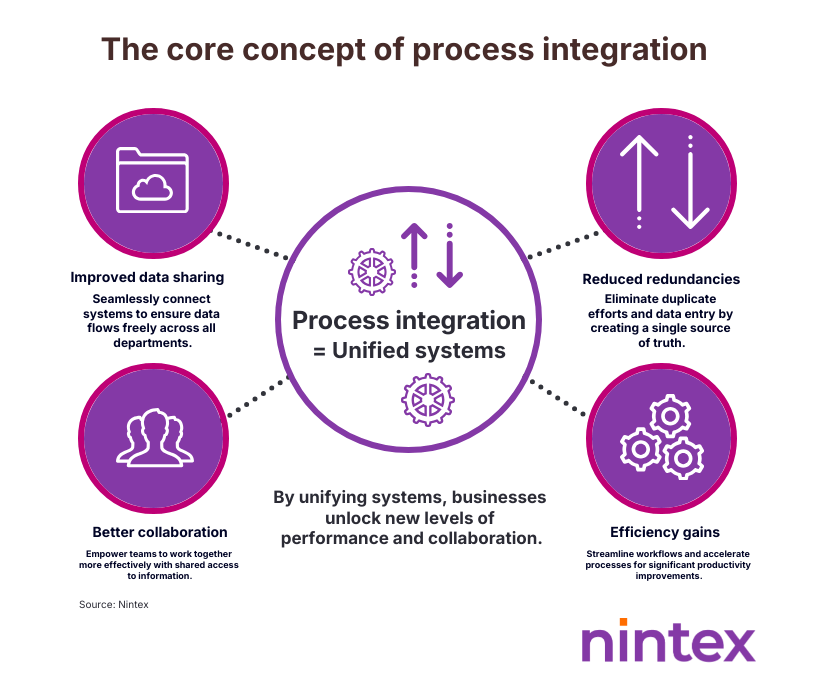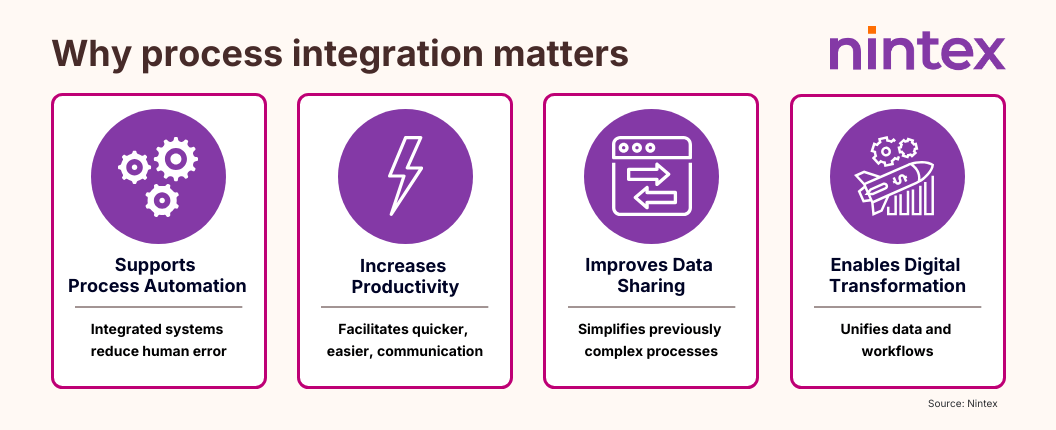In a closed system, variations and fluctuations in processes almost never affect just one area. They affect other processes throughout the system – sometimes significantly, and sometimes in small, hard-to-notice ways. And the bigger a system grows, the more complex its systems become, resulting in piles of interconnected processes. And that is where process integration fits in.
Process integration is a way of understanding a given system based on how each process and tool within that system is connected. Business process integration (BPI) uses this holistic approach to promote harmony internally and externally across all an organization’s tools, teams, and workflows. This is especially true where technology is concerned, as the larger a business grows, the more important it becomes for its tools and systems to scale alongside it (multiple systems integration).
As a business practice, process integration is essential for maintaining efficiency and momentum. It helps ensure all processes (and the technologies those processes use) can continue to support business functions even as conditions change over time.
Definition of an integrated process
Process integration is the coordination and unification of different business processes, systems, and workflows to work seamlessly together. With process integration, organizations will notice improved data sharing, reduced redundancies, and better collaboration across departments and systems. This improves efficiency, enhances decision-making, and creates a cohesive operational environment by aligning processes with organizational goals.
What is an integrated process?
An integrated process is one that contains all the steps, tools, and information essential to completing that process. This means that workers within that process don’t need to look elsewhere for the materials they need to complete their tasks. An integrated process works and communicates seamlessly with other business processes to support overall organizational goals.
Part of business process management (BPM) is ensuring smooth and continuous process integration. It involves assessing and, when necessary, updating existing systems and business operations with new tools and ways of working. In short, it aims to optimize business processes to help meet strategic business goals. (Check out What is process optimization? for more on this.)

Types of processes integrations
Process integration can be understood as an approach to business processes with three major focuses: native integration, API integration, and third-party integration. Each focus serves a different purpose, but overall, all three support an overarching goal of interconnectedness and whole-system efficiency via technology.
Native integration
Native integrations are the most straightforward type of process integration. When two pieces of software are built with native integration functionality, they can easily communicate with each other. No need for APIs or special permissions – native integrations usually only need administrator permission to share data between each other.
API integration
Application programming interface (API) integrations enable different types of software to share information. Software that doesn’t have native integration features must use APIs to communicate with other programs (which also may or may not have integrations themselves). APIs offer organizations more flexibility around their process integration efforts.
Third-party integration
When two softwares are unable to communicate natively or with APIs, organizations have the option of building an in-house solution instead. However, doing so can be expensive, so many businesses opt to use a third-party integration: a software product owned by another company that offers the specialized functions needed at a lower cost.
RPA integration
Alternatively, when two softwares are unable to communicate natively or with APIs, you can use RPA to seamlessly connect the two and communicate between them.
Benefits of process integration

Supports process automation
One of the major benefits of process integration, which takes a technology-driven approach to workflows, is the way it works with an organization’s process automation efforts. Integrated processes are essential for creating seamless workflows free of errors (either human or tech). Their role within an automated workflow is to facilitate quicker, smoother, and more efficient ways of working, freeing up workers’ time and business resources.
(What is process automation? It’s the practice of automating business workflows to reclaim time, money, materials, and human ingenuity. When processes are integrated, businesses can easily automate them via an automation platform with user-friendly tools – no coding knowledge required. For more information, check out low-code vs no-code automation.)
Increases productivity
Process integrations make life easier for everyone involved in a workflow. Not all your workers are software developers, nor should they have to be in order to share data between applications. Integrated systems facilitate quicker, easier communication and sharing between different softwares without demanding additional attention (or advanced coding knowledge) from workers.
Integrated systems are also much more preferable to systems that use multiple, disparate systems to store data. Imagine hunting down information in a workplace where every repository is siloed off, with no way to share data between them. It’s time-consuming for everyone involved, and thanks to modern integrations, it’s just not necessary.
Enables digital transformation
Digital transformation is a hot topic in the modern business world. With so much data to navigate, technology has become more and more necessary as a means of getting actionable insights. Process integration is one of the most impactful of those technologies because it simplifies previously complex processes and makes data-sharing between multiple systems involved in the process much faster and easier. Used in tandem with other process tools – automation, for example – process integration is a game-changer for organizations seeking to gain a competitive advantage through digital transformation.
Business process integration software from Nintex
At Nintex, we build business tools that begin with your convenience in mind. It’s the reason our automation platform is frequently named as one of the user-friendliest solutions available on the market. This commitment to accessibility extends further than just our low-code/no-code tools: it goes all the way to process integration via Nintex Connectors.
Nintex Connectors allows businesses to easily connect their apps and automated workflows with an intuitive drag-and-drop interface. Not only does it offer the ability to connect the most popular business apps used today, it allows organizations to create their own connectors in the event that their app isn’t covered. Contact us for a free demo and see how easy it is to set up your own connectors and get integrated.
Problems and solutions
| Problems | Solutions |
|---|---|
| Data silos and inefficient workflows | Process integration streamlines operations and improves data accuracy |
| Frequent workflow delays and miscommunication | Integrated systems enhance communication and reduce delays |
| Excessive manual data entry | Automation reduces manual tasks, allowing focus on core responsibilities |
| Inability of tools to work together | Nintex solutions enable seamless communication and data sharing |
FAQs
Q. What is the main purpose of process integration?
A. Process integration aims to align and synchronize various business processes to improve efficiency and performance.
Q. How can process integration benefit my organization?
A. It can streamline workflows, reduce costs, enhance data accuracy, and foster collaboration, leading to improved outcomes.
Q. What are the key components of process integration?
A. Key components include data integration, application integration, and workflow integration.
Q. Which industries benefit most from process integration?
A. Industries like healthcare, finance, manufacturing, and retail commonly benefit from process integration.
Q. How does Nintex support process integration?
A. Nintex offers tools to automate workflows, connect applications, and ensure seamless data flow across systems.
Explore these other topics
- What is a workflow?
- What is application development?
- What is citizen development?
- What is intelligent automation?
- What is low code?
- What is low-code automation?
- What is mobile workflow management?
- What is no-code vs low-code automation?
- What is process analytics?
- What is process automation?
- What is process improvement?
- What is process optimization?
- What is workflow automation?
- What is workflow visualization?
